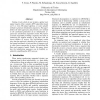Free Online Productivity Tools
i2Speak
i2Symbol
i2OCR
iTex2Img
iWeb2Print
iWeb2Shot
i2Type
iPdf2Split
iPdf2Merge
i2Bopomofo
i2Arabic
i2Style
i2Image
i2PDF
iLatex2Rtf
Sci2ools
ATS
1997
IEEE
1997
IEEE
A Genetic Algorithm for the Computation of Initialization Sequences for Synchronous Sequential Circuits
Testing circuits which do not include a global reset signal requires either complex ATPG algorithms based on 9- or even 256-valued algebras, or some suitable method to generate initialization sequences. This paper follows the latter approach, and presents a new method to the automated generation of an initialization sequence for synchronous sequential circuits. We propose a Genetic Algorithm providing a sequence that aims at initializing the highest number of flip flops with the lowest number of vectors. The experimental results show that the approach is feasible to be applied even to the largest benchmark circuits and that it compares well to other known approaches in terms of initialized flip flops and sequence length. Finally, this paper shows how the initialization sequences can be fruitfully exploited by simplifying the ATPG process.
| Added | 05 Aug 2010 |
| Updated | 05 Aug 2010 |
| Type | Conference |
| Year | 1997 |
| Where | ATS |
| Authors | Fulvio Corno, Paolo Prinetto, Maurizio Rebaudengo, Matteo Sonza Reorda, Giovanni Squillero |
Comments (0)

